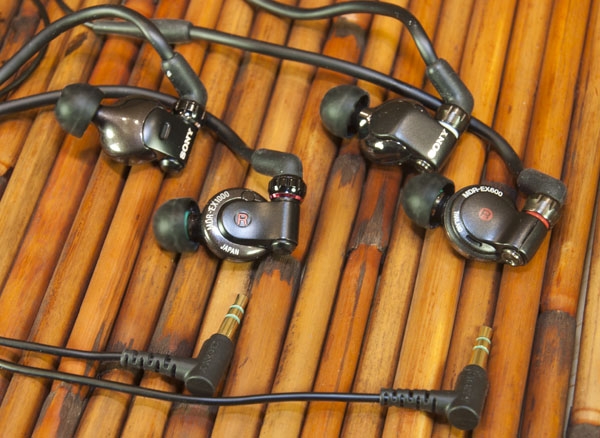| Columns Retired Columns & Blogs |
Sony MDR-EX600 and MDR-EX1000 In Ear Headphones

This story originally appeared at InnerFidelity.com
I've spent a lot of time with good balanced armature monitors stuck in my ears. Mostly it's a pleasure --- there are some darn good headphones out there of this type: Jerry Harvey Audio JH13, Shure SE530, Etymotic ER4P, and Audéo PFE come to mind. I've also spent a good bit of time with in-ear monitors that use dynamic drivers. That hasn't been nearly as pleasurable.
Lately, that's begun to change, and with the Sony MDR-EX600 and MDR-EX1000 I'm thinking we've got a real horse race on our hands.
The Sony MDR-EX600 ($199) and MDR-EX1000 ($499)
These two new dynamic driver in-ear monitors from Sony are rather unusual looking due to their side-firing design. The driver is mounted with its diaphragm surface facing forward, and has a nozzle coming off the edge of the driver enclosure. The advantage of this configuration is that you can have a very large driver and still get it close to the ear. This design is starting to appear more often now and is shared by the Spider Cable Realvoice headphones I reviewed recently and favorably.
As the EX600 and EX1000 share many common attributes, I'll review them together, noting the differences as needed.
Build Quality and Accessories
The build quality of both these headphones appears very good. The EX1000 has a cast magnesium body, the EX600 is not specified, but some parts appear to be metal. Both headphones have driver diameters of 16mm; the EX600 has a multi-layer film diaphragm, while the EX1000 has a liquid crystal polymer film diaphragm.
Both headphone use the same cable, which has a proprietary connector on the earpiece end, and a 90 degree angled 1/8" stereo mini-plug on the other end. The "Y" cable has 18" branches to each ear with a sliding keeper, and the four inches of cable at each ear has a "memory wire" section to retain its form as the wire goes up and over the ears. Overall cable length is about four feet.
Both headphones come with the same mind-boggling array of 10 tips --- 7 sizes of the regular tip (labeled the "hybrid" tip), and 3 sizes of "noise isolation" tip, which has a small donut of foam in the tip to provide a tighter fit in the ear.
The carry case that comes with the headphones is very large, and it's rather complicated to store the headphones in. Personally, I would rather have had something smaller and more convenient that would fit in a pocket.
Ergonomics and Isolation
These earphones have an unusual physical configuration, and it wasn't immediately obvious how to put them on. The drivers are labeled clearly, however, and I like the idea of having the cable route over the top of the ear and snugged together at the back of the neck with the keeper. Once I managed to figure it all out and select the best tip, I found these headphones to be surprisingly comfortable, virtually disappearing after a little while ... quite unusual. Oddly, I had a similar experience with the Realvoice IEM that uses a similar vertically mounted dynamic driver. Something about this configuration works well.
The Sonys did not isolate very well. I did measure isolation with both the hybrid and noise isolating tips and it made no difference at all. MOdest isolation is not necessarily a bad thing. My experience is that most IEMs isolate very, very well, and can be dangerous while walking around as you can become completely unaware of your surroundings. I think in some cases it's wise to wear an in-ear headphone that lets you hear some of your surroundings. When bicycling or skateboarding, for example, it is dangerous to wear headphones that completely isolate. While I can't recommend it as it remains dangerous, these Sony cans would be a good alternative to high-isolation IEMs for these types of activities. On the other hand, if you are looking for headphones for train or airplane travel, I would suggest you look elsewhere. (Etymotic ER4P, Audeo PFE, the Shure SE-line, for instance.)
Also, and this is an odd one, because of the funny shape of these headphones they seem to be prone to making noise on a windy day. There are some comments in the forum threads about this. There wasn't much wind here in Montana during testing, so I stuck my head in front of a fan and did hear significant noise. Um ... sailors and bicycle riders beware?
- Log in or register to post comments




































